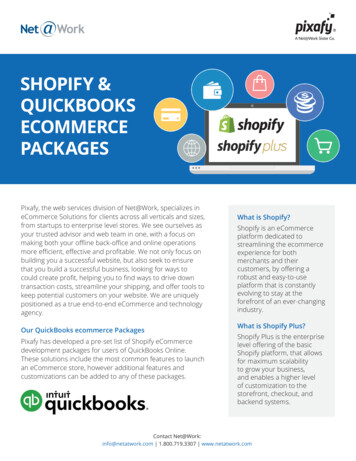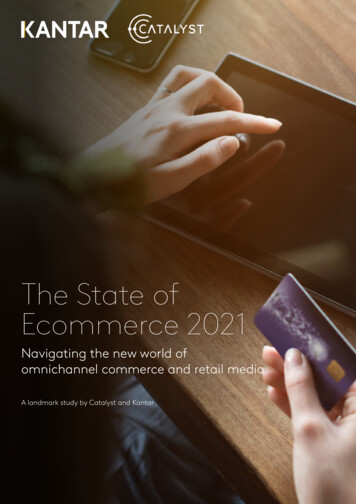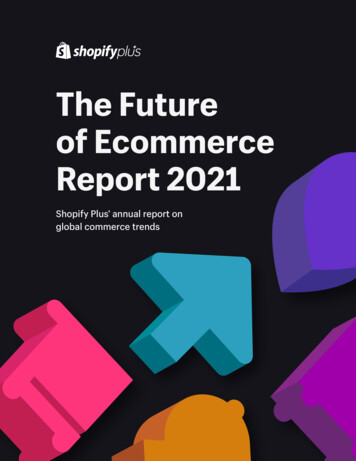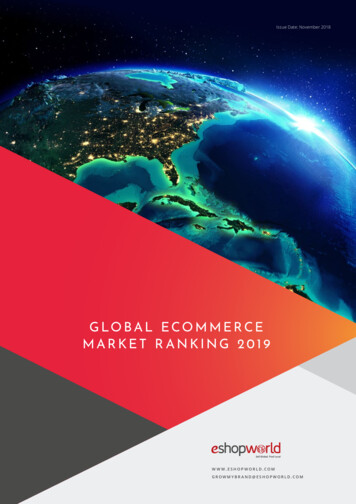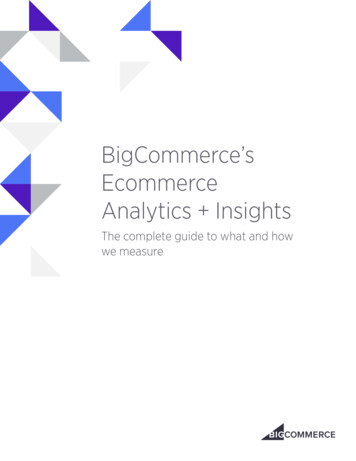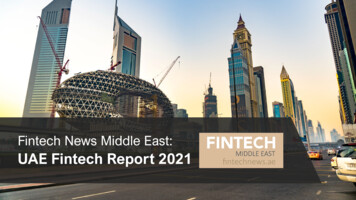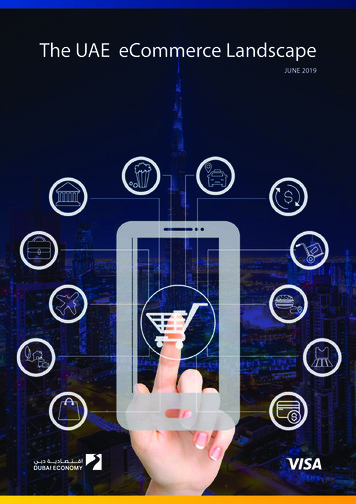
Transcription
The UAE eCommerce LandscapeJUNE 2019The UAE eCommerce Landscape: June 20191
DISCLAIMERSAS ISCase studies, comparisons, statistics, research, and recommendations are provided “AS IS” and intended for informational purposes only and should not be relied upon for operational, marketing, legal,technical, tax, financial, or other advice. Visa Inc. neither makes any warranty or representation as to the completeness or accuracy of the information within this document, nor assumes any liability orresponsibility that may result from reliance on such information. The Information contained herein is not intended as investment or legal advice, and readers are encouraged to seek the advice of acompetent professional where such advice is required.FORWARD-LOOKING STATEMENTSThis presentation contains forward-looking statements within the meaning of U.S. Private Securities Litigation Reform Act of 1995 that relate to, among other things, [our future operations, prospects,developments, strategies, business growth]. Forward-looking statements generally are identified by words such as “believes”, “estimates”, “expects”, “intends”, “may”, “projects”, “could”, “should”, “will”, “continue”and other similar expressions. All statements other than statements of historical fact could be forward-looking statements, which speak only as of the date they are made, are not guarantees of futureperformance and are subject to certain risks, uncertainties and other factors, many of which are beyond our control and are difficult to predict. We describe risks and uncertainties that could cause actualresults to differ materially from those expressed in, or implied by, any of these forward-looking statements in our filings with the SEC. Except as required by law, we do not intend to update or revise anyforward-looking statements as a result of new information, future events or otherwise.THIRD-PARTY LOGOSAll brand names, logos and/or trademarks are the property of their respective owners, are used for identification purposes only, and do not necessarily imply product endorsement or affiliation with Visa.2The UAE eCommerce Landscape: June 2019
ContentsThe UAE eCommerce Landscape: June 2019ForewordObjectivesMethodology455GLOBAL eCOMMERCEShopping: anytime, anywhere7UAE IN MENAA powerhouse in the fastest-growingregion for eCommerce11UAE VS. BENCHMARK MARKETS: TRENDS AND INSIGHTSWho is buying and what’s in the cart in the UAE,compared to mature and emerging markets?lNew eCommerce categories attract spend15DRIVERS OF eCOMMERCEStrengths, opportunities and challenges in the UAElEvolving consumer baselInnovating merchants and paymentslGrowing VC funding and M&AlImproving logisticslEnabling government initiatives23CONCLUSION:An action plan for the futurelA multi-stakeholder approachlRecommendations373
FOREWORDExponential growth ledby digital transformationThe UAE eCommerce market is on an upward trajectory. Its unique growth path, compared to bothemerging and mature economies, is led by government adoption of eCommerce payments onplatforms such as Dubai Smart City. Government payments lead the eCommerce landscape by far,despite exponential growth in other categories such as quick service restaurants and transportation.Logistics infrastructure readiness is necessary to support the growth of eCommerce and in this regardthe UAE is at par with some of the most developed markets in the world. The country enjoys anadvantage as a major global transshipment hub with the port of Jebel Ali and Dubai’s airports providinga high standard of logistics infrastructure. This leadership has been cemented with eCommerce-specificlogistics, exemplified in a June 2018 MoU between Emirates Skycargo and the Cainiao Network, thelogistics arm of the Chinese Alibaba group, aimed at making Dubai one of the eCommerce major’s sixglobal logistics hubs1.A unique feature of the UAE’s eCommerce development is a thriving mall culture. Traditional brick andmortar retailers and malls have been enthusiastic adopters of eCommerce payments, instead of takingan adversarial position as is seen in some other markets. The omni-channel approach is a better routeto consumer hearts. This has been proven by the ‘experience centers’ created by pure-play eCommercebrands such as Amazon globally2. Regionally, Souq.com, which was rebranded as Amazon.ae in April2019, has taken the same approach3.The UAE’s status as an attractive regional destination for start-ups means that consumers haveeasy access to familiar home-grown brands. Start-ups in the UAE remain the most active inattracting funding, with steady investor appetite in UAE-headquartered companies by both localand global majors4.Whether it is seamless electronic management of public transit via the Nol Smart Card or food and fueldelivery by smartphone apps, the UAE’s proactive support on eCommerce incubation has paved theway for consumer trust in online payments.In this favorable ecosystem, the UAE, and to a certain extent, the wider GCC region, has tech-eagercustomers who are now a click away from an eCommerce transaction – anytime, anywhere. Keen touse newer payment methods that are being introduced by various providers, it is clear that once theconsumers try a safe, convenient method, they continue to use it.In this fast-growing market, when eCommerce is becoming the norm, there is still significant opportunityto grow and shape consumers’path to purchase in a way that creates value for the ecosystem.This report captures some of the trends and insights based on Visa’s significant market share, via a deepdive into transaction data. By understanding how and where consumers are spending, the ecosystemcan be supported to continue to develop in a safe, secure and vibrant manner.4The UAE eCommerce Landscape: June 2019
ObjectivesBased on the latest transaction data from Visa, which compares the UAE to emerging and maturebenchmark markets, this report has been undertaken with the objective of supporting the widereCommerce ecosystem comprising the government, investors, entrepreneurs, retailers and otherstakeholders in a developing a multi-faceted action plan.The final aim is to understand the key drivers and challenges of eCommerce with the purpose ofcreating an action plan to support the objective of Dubai’s Department of Economic Development toexpand the eCommerce sector in Dubai and the UAE.MethodologyProprietary data from Visa provides a deep understanding of key commerce and eCommerce driversand trends with transaction sizes, category growth and penetration.The benchmarks help define the UAE market in the context of other markets. For the purpose of thisreport, the benchmark markets are :Mature Emergingl USAl Brazill Canadal South Africal UK l Malaysial Swedenl Australial SingaporeMeasured against these two market clusters, the UAE’s unique strengths and opportunities becomeclearer. The transaction data, backed by other statistics and information from reputed sources, isassessed in the context of eCommerce market dynamics on both the demand and the supply sides.Secondary research for this report includes the summary, collation and synthesis of the latestexisting research from reputed sources, including international organizations such as the World Bankand the United Nations, and surveys on eCommerce undertaken by various stakeholders in the UAEand around the world. It also includes policy and annual results issued by the UAE and Dubai authoritieson the eCommerce sector.1 SkyCargo press statement. July 30, 2018. Emirates SkyCargo signs milestone MoU with Cainiao Network to use Dubai as a hub2. Amazon. Amazon Go – No Lines, No checkout3. Scott, Andrew. The National. March 13, 2017. Souq’s push into physical stores shows e-commerce still has work to do in the UAE4. Magnitt. January 23, 2019. 2018 MENA Venture Investment ReportThe UAE eCommerce Landscape: June 20195
6The UAE eCommerce Landscape: June 2019
1GLOBAL eCOMMERCEShopping: anytime, anywhereEven as eCommerce grows and captures a larger share of the total retail market, there isincreasing convergence between online and offline channels. Continuous innovation isthe key to providing better consumer experiences in the journey from product discoveryto consumption.The UAE eCommerce Landscape: June 20197
Shopping via mobile devices, personal computers, tablets and connected devices is now a partof the everyday lives of consumers globally. Estimates show that global retail eCommerce saleswill be 3.563 trillion in 2019, commanding 13.7% of total retail sales, an increase of 21.5% over12018 , excluding travel2.In 2016, the eCommerce industry gained market share to command 10% of all global retail sales. Sincethen, it has continued to expand exponentially. It is estimated to grow 21.5% in 2019, to hit 4.135trillion by 20202.Even as it continues to carve out a larger share of B2C retail, eCommerce is rapidly evolving to offerconsumers quicker, safer, more intuitive and personalized experiences. The rise of voice-activatedshopping, contextual and social commerce, virtual instant reordering, and product subscriptionscombined with conveniences such as same-day delivery and competitive pricing is drawing moreconsumers to choose eCommerce over traditional face-to-face (F2F) channels.Technological innovation has changed the way consumers discover, interact, purchase and consumeon a daily basis. Virtual assistants powered by artificial intelligence (AI) drive the customer down thefunnel with a higher degree of certainty.Augmented reality, shaped by 3D modeling, is enabling consumers to “test” and “try” products,mimicking in-store experience that customers prefer3. Innovatively rising to the challenge of meetingthe evolving needs of consumers, technology continues to create opportunities to monetize new“shoppable” experiences.Retail eCommerce sales worldwide, 2016-2021 4.878 4.135 3.453 2.842 1.845 %13.7%15.5%17.5%201620172018201920202021Retail eCommerce sales ( trn)% change% of total retail salesNote: includes products or services orderedusing the internet via any device, regardlessof method of payment or fulfillment;excludes travel and event ticketsSOURCE: eMarketer, January 20188The UAE eCommerce Landscape: June 2019
Social media enables contextual commerce in newer ways, discovering moments of buying intentdirectly within platforms and messaging apps. Social media platforms such as Instagram now allow inapp checkout , allowing users to make purchases without leaving the app. Instagram has introducedin-app commerce, which makes it possible for shoppers to buy an item from an ad without leaving thesite to visit the brand’s online store.Smart personalization engines are being used to create individualized offers, product recommendations,and other content based on a customer’s previous actions, demographic profile and other personaldata. These are forecast to lead to a 15% increase in profits for digital businesses by 20204.Payments are no longer limited to facilitating financial transactions, but play a significant role in thevalue chain to deliver benefits across the eCommerce ecosystem. From securing the transaction, toenabling new form factors, to driving value through loyalty and trust, digital payments facilitate secure,frictionless, and easy eCommerce experiences.Expansion of payment optionsWhen it comes to payment options, today’s customers have a variety to choosefrom beyond traditional card based payments, with services such as PayPal,Square, Samsung Pay, Apple Pay and Visa Checkout, among others. These paybuttons remove the hassle of entering payment details for each transaction.It’s common for eCommerce platforms and merchants to offer multiplesecure payment methods to provide the consumer a wider choice. At thesame time, open banking initiatives are driving new data sharing possibilitiesthat remove the need for users to enter their payment data every time theymake a purchase, which can harm conversion rates particularly on mobiledevices.Paymentsplay asignificantrole in thevalue chain todeliver benefitsacross theeCommerceecosystemA web standard in development by the World Wide Web Consortium (W3C) is workingto dramatically simplify online payment processes, overcoming industry fragmentation,diverse payment methods and systems and security issues. Organizations including banks,merchants, credit card providers, browser vendors, device manufacturers, payment system providers,and mobile phone operators are a part of the W3C to make payments easier and more secure on theweb6. Successful implementation of web payments will allow websites to act as payment handlers,while increasing the security and ease of web payments by leveraging the structure of the internetbrowser7.Multiple paths to purchaseWith the continued globalization of eCommerce, localization has come into increased focus. Multicurrency, multi-language, multi-channel eCommerce with localized fulfillment partners is ensuringa contextual experience that can rival traditional F2F retail. In the US, for example, Amazon Gostores allow consumers to buy physical products in a store but checkout digitally8. A combination ofcomputer vision, machine learning and sensor fusion automatically detect products being taken fromand returned to shelves, adding them to a virtual cart, to be billed on the customer’s Amazon account.The UAE eCommerce Landscape: June 20199
In the UAE, online retailer Amazon.ae, which used to be Souq.com, set up “experience centers” to offerthe look and feel that draws consumers to malls and physical stores9.On the other hand, physical retailers and malls are building omni-channel and digital experiences intheir business models, allowing consumers to pay for their shopping using mobile devices, e-wallets,and other flexible digital payment options. One example is the Starbucks app, which has come torepresent consumer loyalty by offering a seamless online-to-offline experience, reaching 23.4 millionusers who have made in-store mobile payment in 2018 in the US. The app lets users pay with theirphones and earn credits toward future purchases10. The “order ahead” feature lets consumers selectand buy coffee on their mobile devices and pick it up in-store. In the UAE, the Al Futtaim group haslaunched a Click and Collect service on several brands including Ace Hardware, allowing consumersto make a purchase online and collect it in-store11.A combination of the latest technology with behavior insights is the future of eCommerce, ensuringbetter user experience (UX) by offering greater convenience, customized experiences, flexible paymentoptions, and instant fulfillment to consumers.1. Koch, Lucy. eMarketer. April 2, 2019. What’s Driving the Top Five Retail Ecommerce Markets Worldwide?2. eMarketer. January 10, 2018. Retail eCommerce Sales Worldwide chart3. Shopify. Shopify AR Powered by 3D Warehouse4. Gartner, Inc. August 26, 2016. Smart Personalization Engines5. Pardes, Arielle. Wired.com. March 19, 2019. Instagram’s new shopping feature makes it a digital mall6. W3C. Backgrounder for W3C Web Payments Standards Work7. Jacobs, Ian. W3C. May 16, 2019. The Next Innovation in Payment Handler Distribution8. Amazon. Amazon Go – No Lines, No checkout9. Scott, Andrew. The National. March 13, 2017. Souq’s push into physical stores shows e-commerce still has work to do in the UAE.10. Kats, Rimma. eMarketer. November 9, 2018. The Mobile Payments Series11. Al Futtaim press statement. September 20, 2016. 2017 ACE Outdoor Living Catalogue now in the UAE10The UAE eCommerce Landscape: June 2019
2UAE IN MENAA powerhouse in the fastestgrowing region for eCommerceThe region has taken its own route to digital adoption and remains the fastest-growingfor eCommerce globally. Within this context, Dubai and the UAE remain a hub foreCommerce growth, whether in attracting start-ups or in creating multiple channels toensure safe and secure payments .The UAE eCommerce Landscape: June 201911
In the GCC, mass internet adoption has resulted from a combination of digital infrastructure andeager consumer adoption of technology-driven solutions, such as social media and smartphones.The wider Middle East and North Africa (MENA) region has taken its own route to digital adoption,leap-frogging traditional channels of evolution.Today, Middle East nations are ahead of more mature eCommerce markets such as the United Statesand China in terms of internet penetration, which stood at 64.5% in 2018, above the global averageof 54.5%1. Delayed adoption, followed by high digital and social penetration, has meant that GCCconsumers have jumped straight to mobile commerce, or mCommerce, and operate across digitalplatforms with ease.The total market size, including all categories, has been estimated to be worth 48.6 billion in 2022, upfrom 26.9 billion in 20181.Even excluding the crucial B2B and C2C eCommerce, food delivery, travel, entertainment, services, andautomobiles categories, MENA eCommerce is forecast to reach 28.5 billion by 2019. With an annualgrowth rate of 25%, MENA is the fastest growing region in the world for eCommerce2.The UAE’s eCommerce sales are projected to hit 16 billion in 2019, followed by KSA, where eCommercesales are projected to reach 7.7 billion3.Currently, the UAE is considered the most advanced eCommerce market in MENA, with apenetration rate of 4.2%; the Kingdom of Saudi Arabia (KSA) follows at 3.8%1. eCommerceMENA outperforms other regionsGlobal eCommerce sales growth (% yoy 2019 forecast)05MENALatin America10AsiaCentral and Eastern Europe (CEE)15Sub-Saharan Africa (SSA)2025North America and Western Europe (NAWE)SOURCE: Fitch Solutions data12The UAE eCommerce Landscape: June 2019
09,68327,08215,9945,0457,50310,00012,341USD mn19,77220,00023,346UAE eCommerce sales30,00020152016e/f RCE: Fitch Solutions datasales in the UAE are estimated to grow by an average of 23% annually between 2018and 20223.The UAE enjoys many advantages that make it ideal for eCommerce growth. Its consumer demographicconsists of a young internet-savvy population, with high social media usage. These people are morelikely than some of their cohort globally to spend time online. eCommerce companies, whether theyare online marketplaces, domestic retailers, or cross-border merchants, are tapping into the high latentdemand, disposable incomes, and digital penetration that is favorable for the sector.Retail sales remain a key driver of economic activity, constituting the most important activity in theservices sector, commanding 26.6% share of GDP in 20174.The UAE retail industry – classified into store and non-store sales, which include eCommerce –is estimated at 55 billion in 2018 and is forecast to rise to 63.8 billion by 2023. The eCommercesegment is classified under non-store retailing, which encompasses online shopping, direct selling,mobile internet, social media and home shopping. The non-store category is forecast to grow by 78%from 2018 to 20235.Developed infrastructure, financial account penetration levels, and supportive government policiesare the foundation for innovation and start-up growth. This, in turn, leads to rapidly increasing depthin the product offering. As a result, the UAE has continued to consolidate its status as the main driverof eCommerce growth in in the GCC and across MENA.The penetration of eCommerce in the UAE is more advanced than MENA at 1.9% and GCC at 3%. Still,there is tremendous potential for growth. Currently, the UAE has eCommerce penetration of total salesaveraging at 4.2% in 2017, similar to countries such as Brazil and Turkey1.The UAE eCommerce Landscape: June 201913
1. Fabre, Cyrille; Malauzat, Anne-Laure; Sarkis, Charbel; Dhall, Tanmay; and Ghorra, Josette. Bain & Company. February 19, 2019. E-commerce in MENA: Opportunity Beyond the Hype, 20192. BMI Research, via The National. June 30, 2018. E-commerce in the region set to be worth 48bn by 20223. Fitch Solutions. November 29, 2018. MENA E-Commerce: Great Growth Potential, Final Mile Challenges Need To Be Navigated4. Dubai Economy. Dubai Economic Report 20185. The Retail Summit press statement. December 10, 2018. UAE’s US 55 billion retail industry forecast to grow 16% by 202314The UAE eCommerce Landscape: June 2019
3UAE VS. BENCHMARK MARKETS: TRENDS AND INSIGHTSWho is buying and what’s in thecart in the UAE, compared tomature and emerging markets?Compared to the benchmark markets, the UAE has a different path for the growthof eCommerce. It enjoys a lead in categories such as government payments. Itsdemographic advantages position it favorably against both emerging and maturemarkets to show healthy growth across categories.The UAE eCommerce Landscape: June 201915
The UAE’s eCommerce landscape is defined by its demographic profile and high income levels,with a high percentage of digital native young adults between the ages of 20 and 39 1. Millennials(born between 1981 and 1996) and Gen Z (born between 1997 and 2012) are considered aninfluential consumer base for eCommerce adoption. Whether it is buying online or using digitalmediums for discovery, research and to eventually purchase at the store, the internet plays a key role.With all infrastructure, tools and options within ready reach, the UAE consumer, at most times, is onlya click away from an online purchase.Visa data show that, drawn by the convenience of shopping online and a varied product offering, theUAE consumer is an enthusiastic adopter of eCommerce, comparing favorably against benchmarks ofboth emerging and mature economies.Government initiatives for cashless transactions have created familiarity with the process ofePayments and facilitating availability of channels. Government payments remain the largest categoryin eCommerce.Card-not-present (CNP) transactions provide a reliable indicator of eCommerce spend. Visa’sCNP transaction data show that UAE eCommerce transactions are growing at a faster pace thanboth emerging and mature markets. In the period between February 2018 and March 2019,eCommerce transactions comprised 28% of the total, growing from 20% during the same periodin 2016-17.The same data show that eCommerce has grown by 31% over the last 12 months, compared to F2Fcommerce, which has shown a 7% increase. The penetration of eCommerce across categories haseCommerce online payments share of volumes20 %11%24 %UAEEmergingmarketsMaturemarketsMar 2016 – Feb 201724 %13 %27 %UAEEmergingmarketsMaturemarketsMar 2017 – Feb 201828%14 %29 %UAEEmergingmarketsMaturemarketsMar 2018 – Feb 2019SOURCE: Visa transaction dataBenchmark emerging markets: Brazil, South Africa, MalaysiaBenchmark mature markets: USA, Canada, UK, Sweden, Australia, Singapore16The UAE eCommerce Landscape: June 2019
UAE consumers lead developing and mature benchmarks in average spend per transaction 34 34Mar 2018 - Feb 2019 79Mar 2017 - Feb 2018Emerging marketsMar 2016 - Feb 2017 81Mar 2018 - Feb 2019 85Mar 2017 - Feb 2018Mar 2016 - Feb 2017Mature markets 26 184 163Mar 2018 - Feb 2019Mar 2017 - Feb 2018Mar 2016 - Feb 2017UAE 144SOURCE: Visa transaction dataBenchmark emerging markets: Brazil, South Africa, MalaysiaBenchmark mature markets: USA, Canada, UK, Sweden, Australia, Singaporegrown rapidly over the last three years. The acceleration puts the preference for the eCommercechannel in the UAE nearly at par with mature benchmark markets.Almost 63% of internet users in the UAE shop online. Their online shopping journeys use search engines,with interest peaking during seasonal shopping events such as Ramadan or White Friday sales2. Drivenby convenience and value, online spending – including domestic and cross-border eCommerce – ison a growth trajectory, from an estimated 12.3 billion at the end of 20183.Average spend per transactionThe UAE shopper is among the top spenders online. In the wider Middle East, North Africa and SouthAsia (MENASA) region, the UAE represents the biggest annual spend per online shopper at 1,648,with growth projected through 2020 at 29.6%4.This is supported by Visa transaction data, which shows that the UAE continues to maintain a healthylead in average transaction size compared to both emerging and mature eCommerce markets. Thetransaction size in the UAE averages 144 in 2018-19, compared to 79 in mature markets and 26 inemerging markets.On the other hand, increasing number of transactions, and reducing ticket sizes, as evident in Visatransaction data, indicate growing comfort with cashless and eCommerce transactions. Consumers aremoving from single large-ticket purchases to everyday spend (such as coffee, groceries, entertainment,and food delivery).The UAE eCommerce Landscape: June 201917
eCommerce online payments share of transactions15%18%20%12%UAE18%13%16%Mature markets11%9%Emerging marketsMarch 2018 - February 2019SOURCE: Visa transaction dataBenchmark emerging markets: Brazil, South Africa, MalaysiaBenchmark mature markets: USA, Canada, UK, Sweden, Australia, Singapore18March 2017 - February 2018March 2016 - February 2017The UAE eCommerce Landscape: June 2019
Tempted by an array of goods, most consumers have experienced the convenience of shopping witha click. A consumer survey revealed that 81% of adults in UAE shopped online in 2017, up from 68% in2016. According to the report, the increase in online spending is also forecast to continue, with almosthalf of online adults surveyed (49%) stating they will increase their online spending in thenext 12 months, citing convenience of shopping online (selected by 65% of those whopredict an increase in their online spend), and the rise in available platforms to shopfrom (40%) as the key reasons for the expected increase3.ConsumersFinancial institutions have tapped into this consumer base by makingavailable mobile payment services including Samsung Pay, Apple Pay andGoogle Pay, in addition to contactless cards and other innovative options.Financial technology is a key part of the payment ecosystem and continuesto be supported.However, there is room to further penetrate on lower spends, where thenumber of transactions in the UAE, according to Visa data, still lags behind thecohort markets. This indicates that continued momentum to drive everydayspend (low-value, high-repeat transactions) such as grocery, food delivery,transportation and subscription services, will prove to be rewarding for growthof eCommerce.are movingfrom singlelarge-ticketpurchasesto everydayspend suchas coffee andgroceryThe UAE consumer is unique in combining a high percentage of online activities with apenchant for malls as social hubs. Malls remain a key part of the social fabric, attracting both residentsand tourists. Historically a part of the social landscape, malls continue to deliver a formidablevalue proposition to the consumer, including creating an omni-channel retail proposition, whichembraces eCommerce6.The UAE eCommerce Landscape: June 201919
Category-wise penetration of eCommercecompared to overall volumesUAE vs. benchmark marketsMarch 2018 - February 20193%13%27%Emerging %3%4%5%8%10%9%2%11%25%Mature marketsGovernment services/EducationAirlinesProfessional servicesTelcoTravel servicesEntertainmentGeneral retail goodsGeneral retail servicesApparel and accessoriesQuick service restaurantsBusiness servicesTransportFood and groceryOthersSOURCE: Visa transaction dataBenchmark emerging markets: Brazil, South Africa, MalaysiaBenchmark mature markets: USA, Canada, UK, Sweden, Australia, Singapore2024%3%4%3%1%4%1%9%5%7%2%The UAE eCommerce Landscape: June 2019
New eCommerce categories attract spendVisa transaction data show that category-wise spend for eCommerce year-on-year is continuing toevolve, with new sectors trying to establish their footprint. eCommerce business models enjoy fasterscaling capabilities compared to traditional brick and mortar retail, and a growing number of retail,grocery, F&B and travel businesses are including online channels.Considering the split by sector over the last three years, it is clear that driven by policy initiativesto promote a cashless economy and digitization of transactions, the categories of education andgovernment payments continue to dominate, with 38% of overall spending share betweenMarch 2018 and February 2019, growing from 25% during the same period in 2016-2017.Market dynamics visible on ground are reflected in the transaction data, in termsof growth of categories. On UAE streets, an increasing number of riders fromConsumerdelivery aggregators such as Talabat, Deliveroo, Uber Eats and Spoonfed arereliance onzipping around to deliver meals to consumers. Consumer reliance on thesefood deliveryfood delivery apps to compare options and order from their restaurants ofapps tochoice is visible in the growth of transactions in that category. Quick Servicecompare andRestaurants (QSR) have increased their share from 1% to 2% year-on-year.The transport category, buoyed by the emergence of ride-hailing servicessuch as Uber and Careem, has also doubled its share from 1% to 2% oftotal eCommerce spend. It also benefits from the seamlessly electronicmanagement of public transit via the Nol Smart Card, which provides access topublic transportation. The card can be applied for, paid for and topped up on theNol e-services portal.order isvisible in thegrowth oftransactionsTo sum up, the UAE enjoys a clear leadership in key areas of eCommerce such as governmentand education payments, retail services (including couriers, health and beauty services) and QSR. It isat par with or close to mature market benchmarks in payments related to telecommunications.However, there is still opportunity to further penetrate several sectors including entertainment spends,retail goods, food and grocery, and healthcare spends. Transport, which is showing exponential gr
In 2016, the eCommerce industry gained market share to command 10% of all global retail sales. Since then, it has continued to expand exponentially. It is estimated to grow 21.5% in 2019, to hit 4.135 trillion by 20202. Even as it continues to carve out a larger share of B2C retail, eCommerce is rapidly evolving to offer


